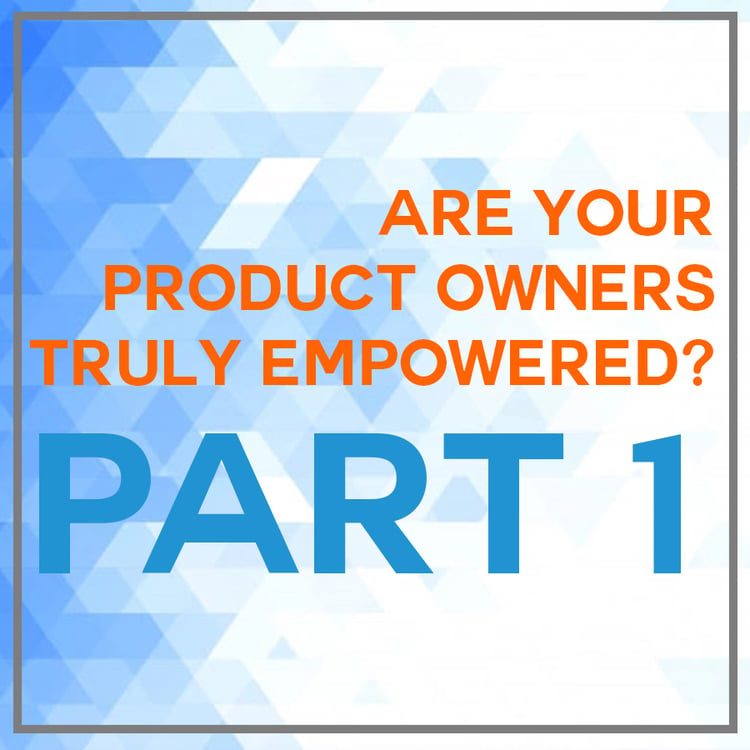Are your Product Owners Truly Empowered? Part 1

The Product Owner plays a crucial role in the success of a team and subsequently the organization. Most organizations consider the Product Owner to be a person with sufficient business knowledge such that they can communicate the business needs to the teams for implementation. While this is an important qualifier for a Product Owner, other factors must be present to have a truly empowered Product Owner.
The following 3 factors have the biggest impact on a Product Owner’s ability to succeed:
- Knowledge
- Empathy
- Psychological Safety
These factors are not just applicable to the Product Owner, but also the surrounding environment. This includes the organization, processes, culture, teams, the product itself, stakeholders, and customers. Let us dig a little deeper.
In this post, we are going to focus on the first influencer: Knowledge. Next week, we’ll take a deeper dive into the impact Empathy has on a Product Owner’s ability to succeed, and we’ll round out the series with defining Psychological Safety and looking at the effect it has on a Product Owner.
Knowledge: The knowledge aspect is the most obvious and widely analyzed and assessed factor to evaluate the effectiveness of a Product Owner. However, there are several dimensions of knowledge that are required.
- Domain Knowledge: This dimension doesn’t need explaining and is probably the most obvious one of all. The Product Owner must have a good understanding of the domain they are working in, to effectively lead product development. While it may seem comfortable to assume that industry-wide it is common practice to have Product Owners with sufficient domain knowledge, some Agile antipatterns have led to the emergence of roles such as proxy Product Owner, or technical Product Owner. The primary culprit for organizations gravitating to this antipattern is a lack of understanding of the Product Owner’s role. Organizations assume that as long as there is a communication path to transfer the business needs to the teams, it is ok to have layers between the customer and the team. This creates dysfunction in Agile teams that are supposed to collaborate with the Product Owner in discovering and delivering value, but don’t have an empowered Product Owner who can make decisions and pivot when needed effectively.
- Process Knowledge: When it comes to a PO having knowledge and understanding of the Agile approach, best practices, and antipatterns usually takes a back seat. To clarify, we are not talking about just having your PO take a 2-day certification class and call it a day. Yes, it is necessary to have formal learning as part of role development, but, the learning should not remain at this minimal level. An effective Product Owner should have lived the process, learned from the challenges, successes, and failures, so they understand what it takes to deliver the product they are helping build
- Knowledge of PO role across in the organization: We talked about knowledge that a PO should have, but, to have a truly empowered Product Owner, an organization needs to know what to do with such a role. As mentioned before, a Product Owner role is different from a mere subject matter expert. To empower a Product Owner to make decisions, the organizational stakeholders need to understand how the Product Owner role works in an Agile context. Product Owners are not only the primary source of information on business needs for the team but are also one of the key roles influencing the pace of value delivery.
If the organization doesn’t understand what it takes for an Agile team to receive business needs Just-in-Time, iterate on requirements, let design emerge, deliver value and allow for slack time and innovation, It will make a Product Owner’s job quite difficult if they are still held to traditional expectations from leadership. These expectations may include providing inflexible delivery commitments, obtaining buy-in from a myriad of stakeholders before any scope changes are made, or worst of all, ensuring maximized utilization from the team. The organization’s stakeholders must be trained and knowledgeable about the basics of Agile if they are new to this way of working. Additionally, leadership must know the common pitfalls, assumptions, and antipatterns that organizations fall into and actively work to avoid or mitigate them.
If you are a Product Owner or your Agile team struggles with this role, join me for a free webinar on Product Owner Empowerment. This webinar will be held on December 12th and you can register here! Space is limited and on a first-come basis.
More from the blog
View All Blog PostsSubscribe to Our Blog
Fill out your email address to receive notifications about new blog posts from CC Pace!

